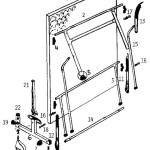Backyard Vegetable Garden Design: A Guide to Cultivating Your Own Fresh Produce
Transforming your backyard into a thriving vegetable garden is a rewarding endeavor that offers a multitude of benefits. From cultivating fresh, healthy produce to enhancing the aesthetics of your outdoor space, a backyard vegetable garden can be a source of pride and satisfaction. To ensure a successful and fulfilling gardening experience, a well-planned design is paramount. By carefully considering factors such as sunlight, soil type, and available space, you can create a functional and visually appealing garden that thrives for years to come.
1. Site Selection and Sunlight
Choosing the right location for your vegetable garden is crucial. Sunlight is a primary factor to consider, as most vegetables require at least six hours of direct sunlight daily. Assess your backyard to identify areas that receive ample sunlight throughout the day. Avoid spots shaded by trees or buildings, as these areas will limit plant growth. Consider the direction of sunlight during different seasons, as the amount of sunlight can vary depending on the time of year.
Additionally, evaluate the slope of the land. Slightly sloped areas can be beneficial for drainage, preventing waterlogging and promoting healthy plant growth. If your backyard is relatively flat, consider creating raised beds to enhance drainage and soil quality.
2. Soil Preparation and Amendments
The success of your vegetable garden hinges on healthy soil. Start by testing your soil to determine its pH level and nutrient content. Most vegetables thrive in slightly acidic soil with a pH between 6.0 and 7.0. Based on the test results, you can amend your soil with appropriate materials to achieve the optimal pH and nutrient levels. For example, if the soil is acidic, you can add lime to increase the pH, while adding compost or manure can improve soil fertility.
Once you have amended your soil, it's crucial to prepare the planting area. Remove any weeds, rocks, and debris to create a clean and fertile surface for planting. If you are working with clay soil, consider incorporating organic matter like compost or shredded leaves to improve drainage and aeration. For sandy soil, add clay or compost to help retain moisture.
3. Vegetable Selection and Planting Plans
Choose vegetables that are well-suited to your climate and growing conditions. Consider the length of your growing season, the average temperatures, and the amount of sunlight available. It's wise to start with a few varieties of vegetables that are relatively easy to grow before venturing into more challenging options.
Once you have selected your vegetables, it's time to create a planting plan. This plan should consider factors like spacing, companion planting, and crop rotation. Some vegetables require more space than others, so it's important to allocate the appropriate distance between plants. Companion planting involves grouping vegetables that benefit from each other's presence, such as planting onions and carrots together. Crop rotation, on the other hand, involves planting different types of vegetables in the same area each year to prevent soil depletion and reduce pest and disease infestations.

Small Vegetable Garden Ideas Gate

Simple Steps To Start A Garden For The Beginner Vegetable Design Small Gardens Backyard

Small Vegetable Garden Ideas Gate

How To Design The Perfect Vegetable Garden Layout Plant

25 Incredible Vegetable Garden Ideas Trees Com

Planning Your Vegetable Garden Mapping The Beds

Small Vegetable Garden Ideas Tips Design

25 Vegetable Garden Design Layout Ideas With Photos

35 Creative Container Vegetable Garden Ideas A Piece Of Rainbow

13 Ideas For A Vegetable Garden With Serious Curb Appeal Bob Vila








